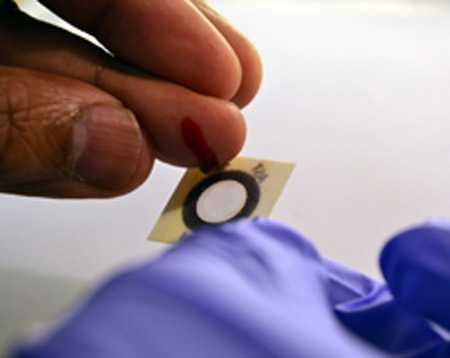Paper-based test can quickly, accurately measure ALT, AST
Researchers have developed a low-cost device that can measure alanine aminotransferase and aspartate aminotransferase levels in 15 minutes using a small amount of blood or serum, according to proof-of-principle studies.
The device, which measures 20 x 20 x 0.5 mm3, consists of two layers of patterned paper laminated in polyester film, along with a plasma separation membrane.
Whole blood or serum is applied in an amount of 30 mcL through a hole in the lamination. Blood cells are held in the membrane while the plasma enters zones in the paper layers testing aspartate aminotransferase (AST) and alanine aminotransferase (ALT). Color changes indicate the results after 15 minutes. The device also features three control zones that validate testing via color change. Results fall into three categories, with additional color gradation within each category: Less than three times upper limit of normal (ULN, 40 U/L) (0 to 119 U/L), three to five times ULN (120 to 200 U/L) and more than five times ULN (more than 200 U/L).
Researchers tested the device using 95 whole blood and 128 serum samples which had already undergone automated transaminase testing. After 15 minutes from application, three masked readers matched the resulting color to a guide and recorded the result to the nearest 10 U/L, then compared this value with the initial automated testing results.

Figure 1. The device is the size of a postage stamp and and can indicate ALT and AST levels from blood or serum samples within 15 minutes of application.
Source: Jason Rolland, PhD
Compared with automated testing, overall accuracy was at 90% or greater for both AST and ALT values in all three categories, using both serum and whole blood as the source. Investigators noted that tests using serum led to more accurate ALT results than those using whole blood, particularly in the three to five times ULN category (92% compared with 57%, P<.00003), but suggested that the difference could be due to the age of the whole blood samples, which can cause artificially elevated ALT values after 6 hours of collection.
Other factors capable of influencing results included pyruvic acid levels above 0.2 mM, which could result in artificially high ALT levels, and ascorbic acid levels above 3 mg/dL, which could indicate artificially low ALT levels.
Investigators also tested the device using 30 mcL blood collected from 10 healthy participants via fingerstick. All 10 devices functioned properly and reflected AST and ALT levels within the expected range of healthy subjects, which matched with automated testing results.
“The experiments presented here have firmly established proof of concept and clinical relevance and will allow us to move into clinical field studies to evaluate the performance of our device in real time using fingerstick blood specimens from those patients for whom we see the device having highest utility, including those with TB, HIV, hepatitis B and hepatitis C,” the researchers wrote.
